Jewish/Zionist Sites
Jericho (Palestinian Authority)
Now the gates of Jericho were securely barred because of the Israelites. No one went out and no one came in.Then the Lord said to Joshua, “See, I have delivered Jericho into your hands, along with its king and its fighting men. March around the city once with all the armed men. Do this for six days. Have seven priests carry trumpets of rams’ horns in front of the ark. On the seventh day, march around the city seven times, with the priests blowing the trumpets. When you hear them sound a long blast on the trumpets, have the whole army give a loud shout; then the wall of the city will collapse and the army will go up, everyone straight in.”
Joshua 6:1-5 (NIV)
Atlit Detention Center (Aliyah Bet)
After the Second World War Jews who had survived the Nazi concentration camps in Europe had few good options regarding their future. Often, their homes were occupied by new tenants and they were not welcomed back to their homes. Some were able to settle in Western Europe or the Western Hemisphere. But for many the Land of Israel was the preferred destination, the Jewish peoples ancient homeland.
Unfortunately British policy at the time restricted immigration. Dozens of ships commanded by the Jewish community’s self-defense organization the Hagana made their from European ports, overflowing with human cargo, to the shores of the Land of Israel. Here offshore many times the British navy intercepted the ships and the refugees aboard were brought to the Detention Center at Atllit.
Today guided tours take us through the camp’s dormitories, showers, and to an actual ship which transported refugees. The camp was closed in 1945 when the Palmah, a part of the Haganah engineered an escape of over 200 prisoners from the camp. As a result, from 1946 until the establishment of the State of Israel illegal refugees were interred on Cyprus.
Sderot
If you want tension and you want to see how people live under threat of rocket attacks over 14 years, come down to Sderot. This community of several thousand has sustained rocket fire from the Gaza Strip, only a mile and a quarter away, for the past 14 years. During major flare-ups parents calculate how long it takes them to grab kids and run for the nearest shelter. They typically have 15 seconds warning before the rocket falls.
Arava Agricultural Settlements
Down at the bottom of the world (the nearby Dead Sea is the lowest place on Earth), in a place where the average rainfall stands at Israeli technology is creating high-tech agriculture. Long growing seasons mean these Israeli farmers have a short window of time in which to beat their European competitors products to the huge, lucrative European market. Stop by and join the farmers for a cold drink.
Kfar Kedem Ancient Village
Want to know what life was like here in the hills of the Galilee during biblical times? Want to keep the kids entertained for a couple of hours while they work off some energy so they’ll go to sleep early tonight? Then this is the place for you. You’ll all dress the part which is surprisingly fun, then get to make your own food and finally go for a slow ride on biblical-era transport: a donkey. Good for kids of all ages.
Genesis Land (Judean Desert)
Set in the stark Judean Desert, just a few minute’s ride from Jerusalem, Genesis Land provides a small glimpse into the lifestyle of the biblical patriarchs from the time of the first book of the bible, Genesis. The site features biblical characters dressed in appropriate garb, camel rides and sumptuous meals served on the floor of open sided tents.
Yad Kennedy
As the Kennedy assassination fades from public memory the Kennedy memorial sees fewer visitors. This gives us an opportunity which is lacking in many other important memorials in Israel, to contemplate, in silence and without disturbance the positive legacy of the 35th President of the United States. The memorial itself symbolizes the 50 states and the District of Columbia and it’s overall shape suggests a felled tree, not allowed to grow to full maturity.
Dead Sea
 The ancient Romans, commenting on the Land of Israel, mentioned three things that set it apart. The Holy Temple in Jerusalem, which contained not a single statue, the Sabbath, when no one worked, and the Dead Sea, in which nothing could live and in which everything floated.
The ancient Romans, commenting on the Land of Israel, mentioned three things that set it apart. The Holy Temple in Jerusalem, which contained not a single statue, the Sabbath, when no one worked, and the Dead Sea, in which nothing could live and in which everything floated.
Today scientists have discovered the therapeutic benefits of the minerals mined from the Dead Sea and as a result a strong cosmetic industry has developed along the shores of the Dead Sea, e.g. at the Ahava Factory Outlet across from Mineral Beach.
In addition the spas and hotels at the Dead Sea resort of Ein Bokek offer treatments for various ailments based on therapies which include the minerals of the Dead Sea and the sunshine.
The Dead Sea has something else going for it which you don’t often hear about but for anecdotal reports: the high concentration of Bromine in the Sea, when found in the gaseous state in the air above the Sea promotes a feeling of well-being. But we cannot at this time claim a scientific basis for these reports (source: “Leisure, Pleasure and Healing: Spa Culture and Medicine in Ancient Eastern Mediterranean”, by Estee Djorvetski in “Supplement to the Study of Judaism” Journal).
Jerusalem’s New City
Jerusalem’s New City began to be populated in 1860 when the Jewish philanthropist and Zionist Moses Montefiore began to encourage Jews living inside the walls of the so-called “Old City” to leave the over-crowded conditions there and settle opposite Mount Zion on the other side of the Valley of Hinom. Today the second neighborhood, called Yemin Moshe, represents the pinnacle of Jerusalem real estate. you can identify the neighborhood across from the Jaffa Gate by its characteristic red roofs and the large white windmill at the top of the hill above the homes of the neighborhood.
Chagall Windows at Hadassah Ein Karem
The Jewish Quarter (Rova) of Jerusalem’s Old City + Mount Zion (Half Day/One Day Tour)

“So solitary lies the city, And at its heart — a wall.” From “Jerusalem of Gold”, by Naomi Shemer. The Western retaining Wall of the Second Temple, object of Jewish yearning for 1944 years.
One could spend a week discovering Jewish roots in Jerusalem’s Old City. Physically, the Jewish Quarter of the Old City is a small place. But what makes it such a rich space for tourists to explore is it’s depth, literally. In several locations you’ll discover an uncovered city under the current Old City quarters. These are places where archeologists have been permitted to explore Jerusalem’s hidden underground treasures.
We will list the primary sites you’ll want to see in a day of Jewish Quarter touring. Refer to the site listings for many more sites.
Entering the Old City from the Zion Gate we approach the Jewish Quarter from the edge of the Armenian Quarter and pass the Rova’s (Hebrew for Jewish “quarter”) parking lot. Soon we come to the Cardo.
We climb steps out of the Cardo and approach the Hurva Synagogue.
Continuing past the Hurva we see below us the Broad Wall.
We cross the plaza of the Jewish Quarter where we approach the Wohl Archeological Museum and the Herodian Mansions.
We continue around the Plaza and find ourselves at the Four Sepharadi Synagogues.
At some point you may wish to take a break at one of the many restaurants near the plaza in the Jewish Quarter/
Now continuing east, we descent the steps and make our way to the Western Wall.
After the Wall we make our way to the nearby Davidson Center and the Southern Wall Excavations.
Mount Zion (Jerusalem)
Mount Zion, mislocated and thus misnamed by the Crusaders in the 12th century, is today, home to at least five significant sites: The Room of the Last Supper (Upper Room), King David’s Tomb, The Dormition Abbey, Oscar Schindler’s grave, and the Church of St. Peter in Gallicantu. Although not in the Old City of Jerusalem, it’s close proximity means that it is often included in tours of the Old City. As you pass between Mount Zion and the Old City through the Zion Gate, note the pock marks on the stones surrounding the gate, evidence of a firefight here between Trans-Jordanian and Israeli forces during Israel’s War of Independence in 1948. At that time Israel lost the Jewish Quarter in the Old City, home to Jews for 600 years. But it managed to retain Mount Zion and thus King David’s Tomb on Mount Zion. The tomb was the closest holy site to Judaism’s holiest site, the Temple Mount, so it became the object of Jewish pilgrimage until Israeli forces took the Old City and Temple Mount in the 1967 Six Day War.
Western Wall Tunnel Tour
Once, 2000 years ago the massive Temple complex was surrounded on four sides by feats of engineering called retaining walls. One of them, on the Western side still stands. But most of it has been covered over the past 2,000 years by houses which were built right up against it. This tour takes you under those houses and allows you to see the length of the wall and beyond it, to the bedrock of Mount Moriah, the holiest place in Jerusalem and therefore, according to some, the holiest place in the world. As you see the visual displays and walk along the wall you will come to understand the Temple’s history and uniqueness in world history. Exit from the tunnel during the daytime is in the Moslem Quarter right at the beginning of the Via Dolorosa. From there you can be escorted back to the outdoor Western Wall complex, or choose to walk through the Old City on your own.
The Palmach Museum
If you’re looking for the most Zionist bang for your buck, this is the place. Prepare to be tear-jerked. But come. We think this is the best hour-long experience you can have in an Israeli museum. But understand this is not a typical museum. Instead, you are taken through a series of halls while listening to the stories of a group of young Palmach soldiers as they meet each other, experience training together through the 1940’s and ultimately fight for the new state of Israel’s survival during it’s War of Independence in 1948. We’ve been here many times and the message never dulls.
The Diaspora Museum (Beit Hatfutsot)
Since the modern State of Israel is composed largely of the ingathering of exiled Jewish communities from around the world, beginning 2,600 years ago with the first exile of Judeans from Judea and Jerusalem to Babylonia (“By the rivers of Babylon we wept as we remembered Zion”), it made sense to dedicate a museum to the history of Jewish exiles from across time and the space. This museum is exhaustive so come prepared to only taste a small part of its offerings, unless you have a week to digest all of it slowly.
Independence Hall (Tel Aviv)
Tension was high. The British were leaving the next day. Egyptian bombers were expected over the skies of Tel Aviv. The next day the land would be invaded by a number of Arab armies. At this precise moment the leader of the Jewish community understood he had to act. David Ben Gurion called a meeting for Friday afternoon, May 14th, 1948. During the meeting which lasted 22 minutes, The modern State of Israel was declared. When you come to Independence Hall you are treated to some of the best guides in Israel who will set the scene for you. The rest is pure emotion.
How to put together your Water and Wine tour of Israel
On our Water and Wine Tours website you will not find standard tours.
Don’t worry. We’ll make sure that you experience the must-see sites in the country. But we’ve also included a comprehensive list of sites, by region for people with many different interests, with enough description for you to ascertain whether it’s the sort of place you want to spend your time.
You know your budget and how much time you have to spend here.
So here are our recommendations, based on years of leading all sorts of tours throughout the country.
- Ask yourself if this trip is a vacation. Do you want to see sites but also feel really relaxed at the end of each day? So that you don’t need a few days of sleep upon your return home? If this is the case then try to restrict yourself to three major sites per day. Between the sites, travel and lunch 8-10 hours will pass quickly.
- If you’re more inclined to describe yourself as a pilgrim or someone who wants a survey of sites, then expect to visit up to five sites per day. You’ll be spiritually satisfied but you’ll also need to get a good night’s sleep every night.
“A life changing event”
"Our guide, Zach Levin, made the trip a life changing event for both Linda and me. He was very sensitive to our needs and went out of his way to make sure we got the full Israeli experience. Zach is very knowledgeable and his passion and enthusiasm contributed to our getting the full flavor of the country."
Harvey and Linda W
Your Tour Guide
Water & Wine Tours specializes in individually tailored tours catering to the interests of its clients. Our founder, Zach Levin, is an experienced, licensed tour guide who majored in Middle Eastern Languages and Cultures at Columbia University in the City of New York.
Our tour guides make the history and culture of Israel come alive. They understand that the customer is always right and want you to experience an unforgettable Israel. We’ll take you to places which you’ll love and never forget. When you need to be left alone we’ll sense it. When you need an extra hand we’re there for you.

